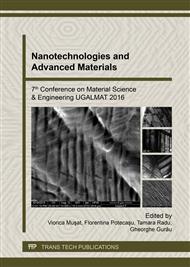p.3
p.7
p.13
p.20
p.26
p.32
p.38
p.45
Study on Ni-Cr-Mo Dental Alloy Subjected to Electrocorrosion in Artificial Saliva
Abstract:
The investigations conducted aimed at determining the microstructural and chemical modifications produced in a Ni-Cr-Mo alloy following electrocorrosion in Afnor artificial saliva by using SEM electronic microscopy and EDS chemical analysis. By 2D and 3D microscopy and by qualitative determinations of the luminous variation we could notice the effects of electrocorrosion tests on the surface of the metallic material, and by EDAX qualitative and quantitative determinations (Point, Line and Mapping modes) of the surface chemical composition we could determine the chemical modifications produced following the corrosion tests.
Info:
Periodical:
Pages:
7-12
Citation:
Online since:
February 2017
Authors:
Keywords:
Price:
Сopyright:
© 2017 Trans Tech Publications Ltd. All Rights Reserved
Share:
Citation:


